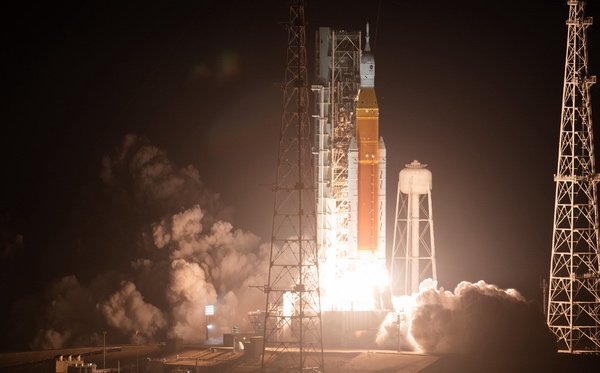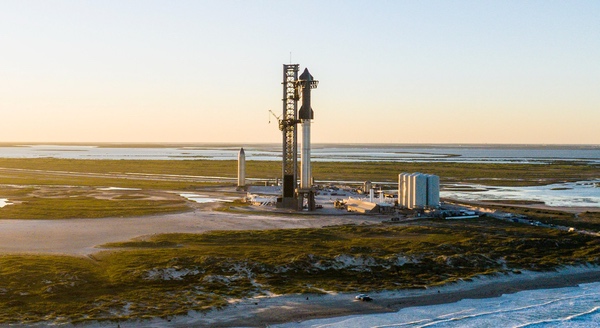Big rockets for big science?by Jeff Foust
|
| These launchers do change what we can do in space,” said Elvis. |
He appeared with two other scientists, Charles Lawrence of JPL and Sara Seager of MIT, to discuss how future large launch vehicles could support missions ranging from large space telescopes to coronagraphs that could be used with those space telescopes to help observe exoplanets.
The benefits of large rockets go beyond being able to accommodate large structures. “You can use mass to solve problems,” Elvis said, allowing the use of less efficient but far cheaper solar panels, or increased shielding for low-cost off-the-shelf electronics.
Similar trades have already taken place on a smaller scale. Lawrence noted that NASA’s SPHEREx Explorer-class astrophysics mission has taken the approach of “converting risk to mass” thanks to the planned launch of the relatively small spacecraft on a Falcon 9. An example, he said, was shifting from original plans for a “technically challenging” Sun-Earth shield using soft goods to a one using more proven aluminum. “This resulted in a much lower risk posture and was enabled by the excess mass capabilities of the Falcon 9 launch vehicle.”
NASA’s biggest commitment to those very large launch vehicles for science missions has been in planning for the Habitable Worlds Observatory (HWO), a future flagship space telescope slated for launch no earlier than the early 2040s. One of the guiding principles that Mark Clampin, director of NASA’s astrophysics division, has laid out for that mission is to use “next-generation” launch systems with greater payload performance that can simplify the design of the spacecraft (see “Unlocking the next great observatories”, The Space Review, January 16, 2023.)
However, these launch vehicles are not a panacea for the problems that previous large science missions have faced. In a presentation earlier at the National Academies meeting, Lee Feinberg, the optical telescope element manager for the James Webb Space Telescope at NASA, discussed the early state of planning for the optics for HWO, including how it could benefit from the use of large launch vehicles.
He said a team has looked at the use of both SpaceX’s Starship and Blue Origin’s New Glenn for launching HWO. Earlier studies, including for a large space telescope concept called LUVOIR, were based on the understanding that Starship could send 20,000 kilograms to the Earth-Sun L-2 point on a single launch.
That is no longer the case. “You have to refuel to get to L-2,” he said. “There’s a lot of details about what would happen to the observatory while it’s sitting in the rocket during refueling.” That includes, he said, potential contamination that could affect HWO’s effectiveness at ultraviolet wavelengths, as well as temperature changes while in orbit.
“They will tell us as they figure this stuff out,” he said of discussions with SpaceX about those issues, “but they can’t tell us this stuff now.”
New Glenn, he said, could get HWO to L-2 on a single launch, but has a mass limit of about 15,000 kilograms for such a mission. “We actually would like a few thousand more than that,” he said. “The closer to 20,000 [kilograms] the better, that’s the way we see it.”
New Glenn also can accommodate smaller spacecraft, with a payload fairing seven meters across versus Starship’s nine-meter fairing. That, he noted, raises issues in designing a spacecraft that can be accommodated by multiple launch vehicles.
| “If I have something that can take 40 metric tons to the Moon,” said McNutt, “I can carry a third and a fourth upper stage and a spacecraft the size of Voyager.” |
Feinberg explained that was a lesson learned from the planning for the Nancy Grace Roman Space Telescope, being built for a mid-decade launch. “Roman designed itself to be compatible with three different rockets,” he said. By the time NASA selected SpaceX’s Falcon Heavy to launch the spacecraft, “it was only rocket they could select at that point. One had dropped out because it was going to be discontinued, one wasn’t ready.”
“Our view right now is that both New Glenn and Starship look promising,” he said, but the Roman experience “highlights the importance of being flexible in rockets.”
 NASA’s SLS could be used for launching science missions, but some worry if the rocket would be affordable. (credit: NASA/Joel Kowsky) |
He did not mention the one heavy-lift rocket currently in service, the Space Launch System. However, it was included in a separate discussion about the use of heavy-lift rocket during a panel discussion at AIAA’s ASCEND conference in Las Vegas last month.
Ralph McNutt, chief scientist for space science at the Johns Hopkins University Applied Physics Laboratory, described how SLS, coupled with two additional solid-motor upper stages, could be used for the launch of a proposed mission called Interstellar Probe that would travel to a distance of at least 400 astronomical units (AUs), or about 60 billion kilometers, from the Sun on a mission lasting half a century or more.
“If I have something that can take 40 metric tons to the Moon,” he said of SLS, “I can carry a third and a fourth upper stage and a spacecraft the size of Voyager.”
The SLS was the best option for vehicles currently available. McNutt said that launching on a fully expendable Falcon Heavy could send the spacecraft towards the outer solar system at a speed of 5 AU per year. The SLS, with additional upper stages, offers 7.5 AU/year. “That really is, right now with what’s available, the best solution.”
The idea of using SLS for launching science missions has been studied for years. However, the closest NASA has come to using SLS for such a mission—or anything other than launches for Artemis—was when SLS was baselined for the launch of the Europa Clipper mission under direction from Congress. However, in July 2021 NASA announced it had selected Falcon Heavy for the launch after discovering potential issues with loads on the spacecraft if launched by SLS.
NASA officials said at the time that supply chain issues would keep use of SLS limited to Artemis missions until at least the late 2020s. “Given the demands of the Artemis program between now and the late 2020s,” said Robert Stough of NASA’s Marshall Space Flight Center at a July 2021 committee meeting, “it’s going to be very difficult to squeeze a science mission in that time frame.”
At ASCEND, some panelists argued that science missions were needed to increase the SLS flight rate and make that vehicle more sustainable. Scott Hubbard of Stanford University, who previously led NASA’s Mars exploration program, said he recalled from a stint on the NASA Advisory Council the importance of increasing the SLS flight rate to “maintain core competency” in its operations.
“We concluded quite emphatically that one a year was not enough,” he said. Doubling that launch date could free up vehicles as “an agency-wide capability for all these other incredible missions.”
| “If the launch costs are $2–3 billion per SLS, how do you afford that without launches eating the rest of NASA’s budget, so there ends up not being enough left to do science?” asked Burns. |
One difficultly in doing so is the cost of SLS. A report last month by NASA’s Office of Inspector General concluded that the Block 1B version of SLS, with the more powerful Exploration Upper Stage, will initially cost $2.5 billion per flight. Efforts to reduce cost, such as shifting production to a joint venture of Boeing and Northrop Grumman called Deep Space Transport, had little prospect of reducing per-flight costs below $2 billion, concluding NASA’s goal of a 50% cost reduction to be “highly unrealistic.”
The same report also noted the failure of NASA so far to find other customers for SLS, including other missions within the agency as well as from the Defense Department. It went so far as to recommend that NASA “monitor the commercial development of heavy-lift space flight systems and begin discussions of whether it makes financial and strategic sense to consider these options as part of the Agency’s longer-term plans to support its ambitious space exploration goals.”
On the ASCEND panel, scientists acknowledged that cost was a major obstacle for any use of SLS for proposed missions. “If the launch costs are $2–3 billion per SLS, how do you afford that without launches eating the rest of NASA’s budget, so there ends up not being enough left to do science?” asked Jack Burns of the University of Colorado. “That’s the conundrum.”
“That’s all about competition,” responded Jim Green, former NASA chief scientist. “It’s all about having other heavy-lift launch vehicles come online like Starship.”
There is also the question of whether there are that many science missions that can make use of SLS. Hubbard suggested SLS could be used for Mars Sample Return (MSR) to help that troubled program deal with its escalating costs and schedule delays. “One of the technical issues that they’re facing is the extreme challenge of fitting the sample return lander, the Mars ascent vehicle, and the arm into a five-meter fairing,” he said. “If you had an eight- or nine-meter fairing—this is possible with some of these super-heavy-lift vehicles—that would extremely relax that particular constraint.”
After an independent review concluded NASA cannot carry out MSR within its current budget and schedule, NASA convened an internal team to look at various alternatives. He suggested that team “take a look at the availability of something like the SLS and see if that could, in fact, serve to relax some of these constraints and perhaps, in the end, make it more affordable.”
During an October 20 meeting of the Mars Exploration Program Analysis Group to discuss the status of MSR, NASA officials did not go into details about what alternatives they are considering, only that they plan to have a recommendation ready for NASA by next March. Asked if NASA was specifically considering Starship in those MSR alternatives, Sandra Connelly, deputy associate administrator for science, said NASA was including “partnerships with industry” among those alternatives, but was not more specific.
Others said they were not considering clean-sheet or other radical redesigns of MSR. “We’re looking to harvest as much of the work that we’ve done to date as possible, but also stepping back and looking at ways we can reduce cost and increasing resilience,” said Jeff Gramling, MSR director at NASA headquarters, at that meeting.
Even advocates of using heavy-lift rockets for science missions acknowledge challenges that approach faces. “New launchers do expand the design space but they don’t solve every problem. There are negatives as well,” Elvis said at the National Academies meeting. Larger and heavier spacecraft, he said, might be enabled by heavy-lift rockets but will require more propellant for stationkeeping and larger reaction wheels.
However, heavy-lift rockets will likely be considered for future flagship missions, even if they don’t add substantial demand for such rockets. “The availability of greater mass and volume and size capability at lower cost enlarges the design space,” Lawrence said. “We want to take advantage of that.”
Note: we are using a new commenting system, which may require you to create a new account.
